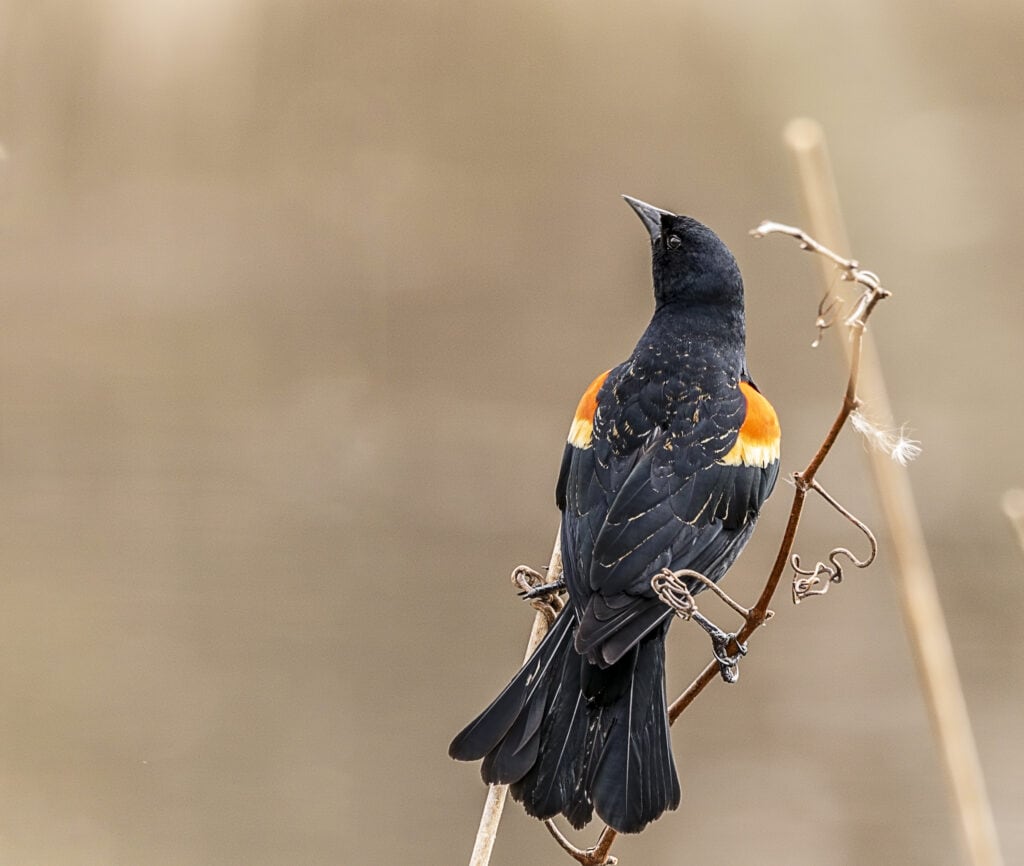America’s wetland marshes, and the tall reedy grasses that grow within them, are a haven for an abundance of birds ranging from elegant wading birds to gregarious flocks of ducks and geese to busy little gatherings of sparrows. In a way, birds are the true inhabitants of wetlands. Sure, there are bugs and amphibians and mammals that live at the edges of America’s waterways, but to take a walk through a wetland trail is to birdwatch. And no bird rules the marshes like the Red-winged Blackbird.
Shiny black feathers with a striking patch of red, fluid musical songs, and cacophonous abundance are the traits that I most associate with the Red-winged Blackbird. It is a true member of the Icteridae family of New World blackbirds; bold and entertaining.
Related Article: Species Spotlight: The Rhinoceros Hornbill
Fun Facts About the Red-winged Blackbird
Red-winged Blackbirds are beautiful birds brimming with personality. Let’s explore that personality with some Red-winged Blackbird fun facts designed to help you appreciate your next walk through the wetlands that much more!
Soap opera romances: Red-winged Blackbirds are known for being polygynous. This means that a single male will often have more than one female mate. In fact, a male may defend a territory with as many as 15 female mates in it. This sounds like a lot, and it is, but the truth is even more scandalous. As many as half of the nestlings born in a male’s territory are likely to have been fathered by another male.
Camouflaged females: To defend their territory from other males, Red-winged Blackbird males will perch somewhere high up and flash their red wing patches as they sing. This brash display starkly contrasts the female’s survival strategy. Female Red-winged Blackbirds are neither red-winged nor black. This species exhibits sexual dimorphism, which means that males and females have different appearances. The female is a streaky brown color that helps her blend into the reeds and grasses of the marsh where she stealthily builds a nest.
Laughing in the face of danger: If camouflage isn’t enough to hide a female, her mate might just have to step in and defend her. For most songbirds, fighting off predators is a tall order, but the Red-winged Blackbird fearlessly takes on the challenge. These birds are known for attacking larger predators. And when I say larger, I mean larger. Male Red-winged Blackbirds will sometimes even attack people who enter their nesting territory and wander too close. For most predators, the Red-winged Blackbird’s attack is annoying or distracting enough to turn them away from the nest site. So, the dangerous gamble of attacking larger animals often pays off.
Birds of a feather: The Red-winged Blackbird currently holds the world record for the Christmas Bird Count’s highest count number of a single species. In Arkansas in 1964 over 40 million Red-winged Blackbirds were counted. This is an enormous number, but flocking in big groups is not a one-off for the Red-winged Blackbird. They often flock with other Icterids including grackles and starlings and can be found in flocks numbering well over a million birds.
The Future of the Red-winged Blackbird
The International Union for the Conservation of Nature’s Red List of Threatened Species lists the Red-winged Blackbird as being of “Least Concern.” This is hardly a surprise considering the fact that Red-winged Blackbirds are an extremely common species with an estimated population that numbers over 200 million individuals. Despite this abundance, though, these ubiquitous wetland birds are declining. The future of the Red-winged Blackbird may be assured for many more years based on population density alone, but this decline is troubling and must be stopped if future generations are to enjoy the boisterous song of the American wetlands.
Popular Article: Florida’s State Bird May Be Changing Soon

